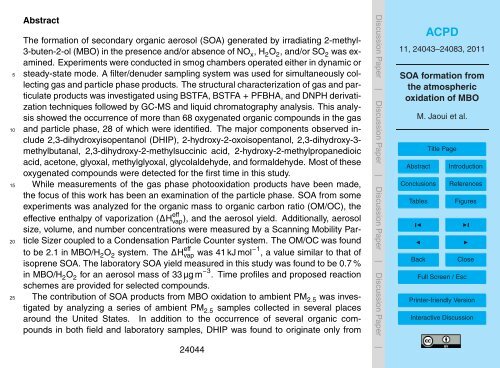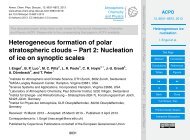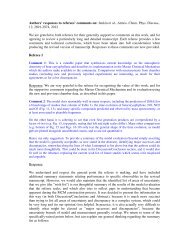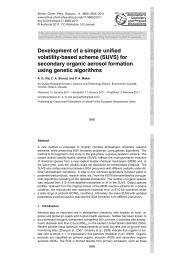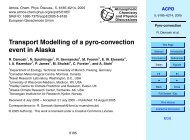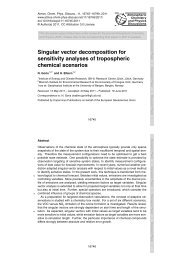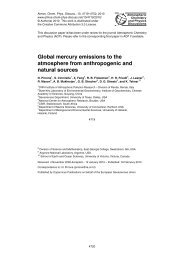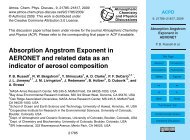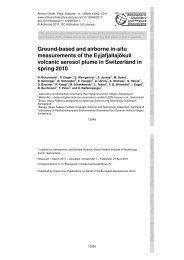SOA formation from the atmospheric oxidation of MBO - ACPD
SOA formation from the atmospheric oxidation of MBO - ACPD
SOA formation from the atmospheric oxidation of MBO - ACPD
Create successful ePaper yourself
Turn your PDF publications into a flip-book with our unique Google optimized e-Paper software.
5<br />
10<br />
15<br />
20<br />
25<br />
Abstract<br />
The <strong>formation</strong> <strong>of</strong> secondary organic aerosol (<strong>SOA</strong>) generated by irradiating 2-methyl-<br />
3-buten-2-ol (<strong>MBO</strong>) in <strong>the</strong> presence and/or absence <strong>of</strong> NO x, H 2O 2, and/or SO 2 was examined.<br />
Experiments were conducted in smog chambers operated ei<strong>the</strong>r in dynamic or<br />
steady-state mode. A filter/denuder sampling system was used for simultaneously col-<br />
lecting gas and particle phase products. The structural characterization <strong>of</strong> gas and particulate<br />
products was investigated using BSTFA, BSTFA + PFBHA, and DNPH derivatization<br />
techniques followed by GC-MS and liquid chromatography analysis. This analysis<br />
showed <strong>the</strong> occurrence <strong>of</strong> more than 68 oxygenated organic compounds in <strong>the</strong> gas<br />
and particle phase, 28 <strong>of</strong> which were identified. The major components observed in-<br />
clude 2,3-dihydroxyisopentanol (DHIP), 2-hydroxy-2-oxoisopentanol, 2,3-dihydroxy-3methylbutanal,<br />
2,3-dihydroxy-2-methylsuccinic acid, 2-hydroxy-2-methylpropanedioic<br />
acid, acetone, glyoxal, methylglyoxal, glycolaldehyde, and formaldehyde. Most <strong>of</strong> <strong>the</strong>se<br />
oxygenated compounds were detected for <strong>the</strong> first time in this study.<br />
While measurements <strong>of</strong> <strong>the</strong> gas phase photo<strong>oxidation</strong> products have been made,<br />
<strong>the</strong> focus <strong>of</strong> this work has been an examination <strong>of</strong> <strong>the</strong> particle phase. <strong>SOA</strong> <strong>from</strong> some<br />
experiments was analyzed for <strong>the</strong> organic mass to organic carbon ratio (OM/OC), <strong>the</strong><br />
effective enthalpy <strong>of</strong> vaporization (∆H eff<br />
vap), and <strong>the</strong> aerosol yield. Additionally, aerosol<br />
size, volume, and number concentrations were measured by a Scanning Mobility Par-<br />
ticle Sizer coupled to a Condensation Particle Counter system. The OM/OC was found<br />
to be 2.1 in <strong>MBO</strong>/H 2O 2 system. The ∆H eff<br />
vap was 41 kJ mol −1 , a value similar to that <strong>of</strong><br />
isoprene <strong>SOA</strong>. The laboratory <strong>SOA</strong> yield measured in this study was found to be 0.7 %<br />
in <strong>MBO</strong>/H 2O 2 for an aerosol mass <strong>of</strong> 33 µg m −3 . Time pr<strong>of</strong>iles and proposed reaction<br />
schemes are provided for selected compounds.<br />
The contribution <strong>of</strong> <strong>SOA</strong> products <strong>from</strong> <strong>MBO</strong> <strong>oxidation</strong> to ambient PM 2.5 was inves-<br />
tigated by analyzing a series <strong>of</strong> ambient PM 2.5 samples collected in several places<br />
around <strong>the</strong> United States. In addition to <strong>the</strong> occurrence <strong>of</strong> several organic compounds<br />
in both field and laboratory samples, DHIP was found to originate only <strong>from</strong><br />
24044<br />
Discussion Paper | Discussion Paper | Discussion Paper | Discussion Paper |<br />
<strong>ACPD</strong><br />
11, 24043–24083, 2011<br />
<strong>SOA</strong> <strong>formation</strong> <strong>from</strong><br />
<strong>the</strong> <strong>atmospheric</strong><br />
<strong>oxidation</strong> <strong>of</strong> <strong>MBO</strong><br />
M. Jaoui et al.<br />
Title Page<br />
Abstract Introduction<br />
Conclusions References<br />
Tables Figures<br />
◭ ◮<br />
◭ ◮<br />
Back Close<br />
Full Screen / Esc<br />
Printer-friendly Version<br />
Interactive Discussion


